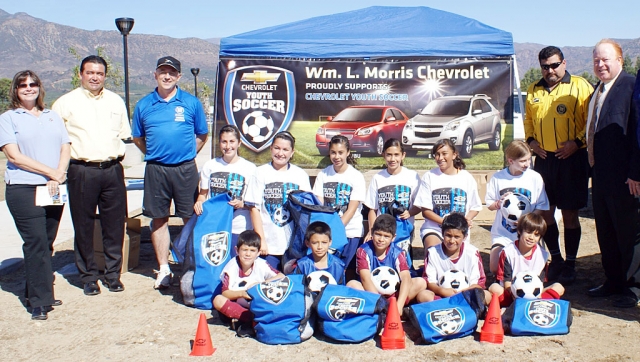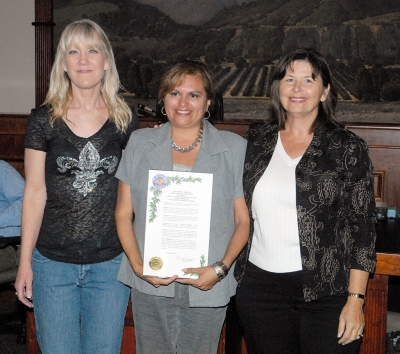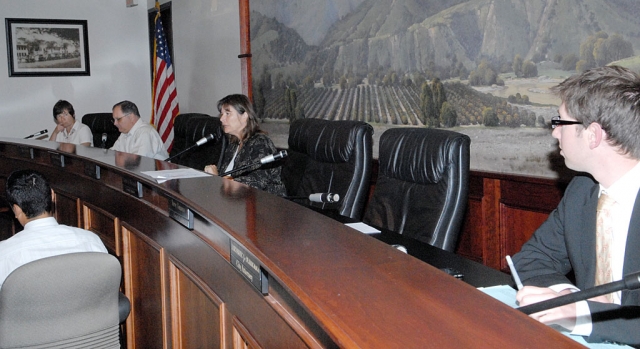|
By Anonymous — Wednesday, October 27th, 2010
 Since 1984 Taco Bell has neen on highway 126 serving the town of FIllmore and highway traffic. But now after 26 years they are tearing it down and putting up a brand new building. But this time, it will be Taco Bell/Pizza Hut Express. They expect it to be closed for approxiamelty 3 months. If you can’t wait you can always visit the Santa Paula Taco Bell. Enlarge Photo |
|
By Anonymous — Tuesday, October 26th, 2010
 Deputy Jerry Peterson received the “Students First” award during Tuesday night’s school board meeting. On Tuesday October 19th the Fillmore School Board met for a regularly scheduled meeting at the Fillmore Unified District Office. Members in attendance were Board President Tony Prado, Board Clerk Liz Wilde and Board Member Mike Saviers. Following a public comment period with no speakers the Board recognized Deputy Jerry Peterson with a “Students First” award for this role in past years as School Resource Officer for the District. This seemed to prompt Prado to comment on an item that was not included in the evening’s agenda. Prado stated “[there are issues being raised] with the Board elections”. He went on to say that “the issue is that we have a high crime rate in our schools, that we have problems in our schools, and I just need to clarify”. Prado then instructed “some of the candidates” to meet with the “head guy” to learn that “we don’t sweep things under the rug in Fillmore… we take care of the situation.” He clarified that District staff are following Board instructions to “carry through with any law breaking that is taking place…we want to take care of the situation immediately… Jerry has done that, the principals have done that.” Prado continued his clarification stating “it may appear that we have a higher rate of discipline problems or maybe arrests but I know how they handle it in other districts.” He concluded by thanking Peterson and the principals for not “hiding” the situation. Student Rep Sean Chandler reminded the Board that there was no school last week, and that the High School is starting a new quarter and new “tutorial session” so that students who have been recognized as needing the “extended lunch break” can get the extra help they need. He announced the upcoming football game against Nordoff on Friday, as well as the approaching Senior Ball on Saturday. On Thursday the Seniors will have the opportunity to meet with representatives from different colleges they may be interested in attending. Chandler concluded with a reminder about the 100th Fillmore vs. Santa Paula football game that is taking place in November. During Board reports CONTINUED » |
|
By Ventura County Sheriff Department — Wednesday, October 20th, 2010
On October 18, 2010 at about 1:30 p.m., deputies assigned to the Fillmore Station arrested a 21-year-old Fillmore resident, Gildardo Sebastian Sanchez, for misdemeanor hit and run resulting in property damage to the Fillmore Historical Museum and for driving without a license. On the same date at about 10:30 a.m., deputies were sent to investigate property damage caused overnight to the Fillmore Historical Museum located at 360 Main St., Fillmore. The building sustained damage to the front wall and block foundation. When deputies arrived, they found evidence at the scene that indicated a vehicle had crashed into the front of the building and the driver had fled the scene. A Fillmore City Motor Officer and station investigators consulted auto experts to narrow down the suspect vehicle make and year. Three hours later, a Fillmore patrol deputy located the vehicle involved. It was a Chevy Blazer SUV, parked in the 600 Block of Fillmore St. The vehicle had major front-end damage and evidence directly linked to the crime. Further interviews led to the arrest of Sanchez. He was issued an arrest appearance citation for the misdemeanor violations, and released on his own recognizance. Location: Fillmore Historical Museum, 360 Main St. Fillmore, Ca. 93015 Officer Preparing Release: Detective Taurino Almazan |
|
By Anonymous — Wednesday, October 20th, 2010
 The cause of an accident on the 100 block of Ventura Street between a car and pickup which occurred about noon, Monday, was not announced at press time. The occupant of the car was taken to a local hospital for observation. Enlarge Photo  The extent of any serious injuries is not known. Extensive damage was suffered by both vehicles. Enlarge Photo |
|
By Anonymous — Wednesday, October 20th, 2010
Question #8
November 2nd you will be able to vote for TWO City Council candidates Question #8: Members of the council don’t always agree. How will you deal with inter-council disagreements, criticism from the community and scrutiny from the media? Alex Mollkoy: As your Councilman, I will stand my ground on the issues that are in the best interest of the Citizens. I will work hard to acknowledge and understand the differences of each council member. We must communicate with respect, in order to conduct civic business in the best interest of the public. I will ask that we all use common sense in our review of each and every item that comes before the City Council. Patti Walker: The City has an adopted Rules of Decorum that dictate how council members treat one another as well as the public. Council members should not dispute the truth, validity, or honesty of another member. They should not utter words that are offensive. The Council is to provide an atmosphere where debate of the issues occurs rather than engaging in a discussion of another’s character or showing disrespect to the City. David Lugo: There will always be disagreements that is why there is an odd number of council-persons but you must always remember you represent the community and keep it professional and respectful to one another. Criticism will never go away that is a way of people getting their point across, you must stand firm in your decision and give explanations to the community and media for your decision for them to understand your decision not just blow them off. I believe you earn respect and appreciation that way and avoid scrutiny from them. "Your Voice" Brian Sipes: City Council members are elected to make good sound policy for the community at large. I welcome peaceful disagreements between Council members as I feel that in order to make good sound policy, all opinions and facts must be considered and debated. If entrusted to be a Council member, I will not be one that maligns other Council members to further their personal political agendas. Working together doesn't mean agreeing 100% of the time, but conducting City business on behalf of the citizens is first and foremost my priority and should be of those seated at the dais. |
|
By Anonymous — Wednesday, October 20th, 2010
Question #8
November 2nd you will be able to vote for THREE School Board candidates Question #8: Several Ventura District schools are offering a dual-language, two-way immersion, where students are learning in and speaking Spanish for 90 percent of the school day and English for the remaining 10 percent. What is your opinion of this type of program? Do you support total immersion or two-way immersion? Explain why. Mark Austin: In this rapidly changing world, students need all the tools that can be provided to them for success. Proficiency in a second language is just one of these important tools. In my opinion, a dual-language immersion program could be an important component of a student’s education. Two-way immersion (TWI) appears to be the best method to obtain proficiency in a second language. A TWI program is not intended to replace English with another language, but rather to provide a student the chance to gain another language. In the TWI method, English speaking students starting in kindergarten are taught in Spanish for 90 percent of the time and in English for 10 percent of the time, with the ratio of Spanish to English gradually evening out. By the time the student reaches sixth grade, they are being instructed 50 percent in Spanish and 50 percent in English. Of course, if the Fillmore Unified School District (FUSD) were to implement a TWI program, student participation would need to be at the discretion of the parent. Dave Wilde: Offering dual immersion programs at some of our school sites would be one of those great ways to offer parents a choice in their child's education. We have a couple of unified district employees who have experience with this program and speak in its favor. When discussing this program with educators and parents you get mixed feedback. The one concern I hear the most is that normal academic learning may be inhibited. I have not seen any studies, or data that support this fear. So, if this is not the case what a great opportunity it would be for young students to learn and become proficient in two languages. In my professional world the ability to speak two languages is definitely a huge asset. It would certainly provide more opportunities for our graduates when entering the world after schools. Kimberly Rivers: All students would benefit from being “bi-literate” in today’s global economy and diverse communities. I support “dual” immersion programs that incorporate high levels of staff and parental input. Because these programs require staff to teach in a different way and close collaboration with parents to ensure that students have adequate support out of class, buy-in from staff and parents is vital to their success. In addition I feel the District has the role of being proactive in bringing programs before the community that will improve and broaden the education provided to students. Tony Prado: Dual immersion or two way immersion is the political correct term for bi-lingual education, and total immersion is simply English only in the classroom. Recent research shows that either program works. To implement a two way immersion program the school site must have a well trained and dedicated staff to make it work. Two way immersion requires more work on the part of teachers than the regular teaching staff. Most often these teachers are paid more than the regular teachers and this can cause some problems. Also, two way immersion programs will cost more money for materials and supplies. The benefit is students at an early age will learn two languages and have a career advantage in an inter-dependent global society. Lucy Rangel: Several Ventura District schools are initiating a program whose goals are to promote bilingualism, grade level academic achievement, and positive cross-cultural attitudes and behavior of all children. Two-way immersion is a form of dual language instruction that brings together students from two native language groups for language literacy, and academic content instruction through two languages. In my opinion, a two-way immersion program would be much more beneficial than a program of total immersion. Immersion programs use a foreign language to teach the entire curriculum. |
|
By Anonymous — Tuesday, October 19th, 2010
The California Department of Public Health (CDPH) is warning consumers not to eat sport-harvested shellfish or some parts of crustaceans or small finfish from offshore the Channel Islands. Elevated levels of the toxin, domoic acid, has been detected in recent samples of mussels, clams, scallops, and the viscera of lobster and crab. Domoic acid can be harmful to people. This warning does not apply to commercially sold clams, mussels, scallops or oysters. State law only permits state-certified commercial shellfish harvester or dealer to sell these products. Shellfish sold by certified harvesters and dealers are subject to frequent mandatory testing. No cases of human poisoning from domoic acid are known to have occurred in California. Symptoms of domoic acid poisoning can occur within 30 minutes to 24 hours after eating toxic seafood. In mild cases, symptoms may include vomiting, diarrhea, abdominal cramps, headache and dizziness. These symptoms disappear within several days. In severe cases, the victim may experience difficulty breathing, confusion, disorientation, cardiovascular instability, seizures, excessive bronchial secretions, permanent loss of short-term memory, coma and death. To receive updated information about shellfish poisoning and quarantines, call CDPH toll-free “Shellfish Information Line” at (800) 553-4133. You may also receive additional information from the California Department of Public Health at www.cdph.ca.gov |
 William L. Morris Chevrolet and Fillmore AYSO are participating in a fundraiser to help raise money for AYSO. Players will be selling raffle tickets for a chance to win a car. All proceeds from the raffle will go directly to Fillmore AYSO. Pictured above (l-r) standing: Mayor Pro-tem Gail Washburn, Fermin Sarabia, Perrie Gerardy, Greg Aguilar, and Chap Morris. The soccer players in alphabetical order: Diana Aguilar, Amanda Armstrong, Adrian Beserra, Marcos Cardenas, David Dunham, Kendra Magana, Adrian Martinez, Raylene Martinez, Jovanni Olivera, Grace Topete, and Sarah Vollmert. For more information regarding the raffle please contact Greg Aguilar. Photo courtesy Sespe Sun. Enlarge Photo By Chap Morris — Wednesday, October 13th, 2010
Wm. L. Morris Chevrolet in celebrating their 81st year as a proud Chevrolet Dealer hopes to help Fillmore AYSO score big
Wm. L. Morris Chevrolet teams up with Fillmore AYSO to help raise thousands of dollars for youth soccer program. In the spirit of teamwork taught by youth sports, Wm. L. Morris Chevrolet is teaming up with Fillmore AYSO to provide their players and coaches with soccer kits filled with equipment bags, soccer balls, sport cones, practice jerseys and t-shirts, a monetary donation and an opportunity to help them raise funds. Fillmore AYSO will have the opportunity to raise as much as $20,000 through a fundraising opportunity where one lucky recipient will win his or her choice of a 2010 Chevrolet Equinox or Malibu. Another lucky winner will receive a Home Entertainment Package. Wm. L. Morris Chevrolet the exclusive sponsor in Ventura County, and other Los Angeles-area Chevrolet dealerships are donating these prizes to participating leagues in the area. One-hundred percent of the proceeds go directly to the leagues, and they can use the funds in any way they choose. Some leagues plan to grant scholarships to families who cannot afford to enroll their children in the league, while others will use the funds to improve fields and equipment. “We are proud to CONTINUED » |
|
By Jean McLeod — Wednesday, October 13th, 2010
 Jane David and Soroptimist International of Fillmore President Ari Larson received a proclamation declaring October as “Breast Cancer Awareness Month” from Mayor Pro-Tem Gayle Washburn. Enlarge Photo With Mayor Patti Walker and councilpersons Steve Conaway and Laurie Hernandez not in attendance at Tuesday night’s Council meeting, not much was accomplished. Only Councilmembers Gail Washburn and Jamey Brooks were in attendance along with Fillmore City Attorney Ted Schneider and Fillmore City Manager Yvonne Quiring. With only two councilmembers present a quorum could not be reached and as a result, nothing on the agenda could be approved or moved forward. The meeting started off with a joint proclamation to Soroptimists International declaring October “Breast Cancer Awareness Month” with the theme “Color Me Pink” and November “End Domestic Violence Month” with the theme “Color Me Purple.” The Public Comments section started off with Alex Mollcoy announcing his candidacy for City Council as a write-in. Mollcoy stated he would like to see more jobs come to Fillmore and his desire for smart responsible growth which he sees in the proposed Business Park. Marie Wren spoke to the Council in rebuttal to the last council meeting where the City Staff’s letter of no confidence in regards to City Manager Yvonne Quiring was read. Wren defended Quiring by stating Quiring always gave her time and attention when asked and even though they didn’t always agree on everything “she saw that things got done.” Fillmore resident Raelene Chaney, who for years has volunteered her time and effort toward seeing that Fillmore High School Seniors have a safe and fun graduation celebration, came to remind the council it was time for the “Grad Night Live” pie sale. The proceeds from the sale of the pies will help raise the $21,500 needed for the 275 students expected to attend the 2011 Graduation Celebration. The Marie Calendar pies are selling for $11 each and arrive in time for the Thanksgiving Holiday. The pies are available in both regular and sugar free. The Heritage Valley Aquatics CONTINUED » |
|
By Anonymous — Wednesday, October 13th, 2010
Alex Mollkoy, Write-in Candidate for City Council
"Let’s restore common sense to City Hall. We must bring back a sense of unity to all the people of this great little town we all call home. We can make this a better place. Let us continue on with the traditions and good values we all cherish for our small town community. We owe it to ourselves, our neighbors and our visitors." Who am I? I grew up in a small town of eight square miles called Fountain Valley, California. In the 1960’s this small town in Orange County was first a farming community next to the Santa Ana River. I remember sand bagging the river banks during storm season before the city had built the levees. As I grew up there I watched it grow into one housing tract after another; they called them planned communities. By the time I graduated High School the entire eight square miles except for “Mile Square Park”, became planned communities with strip malls. Let’s not have that happen here in Fillmore. I believe in smart responsible growth for any community. There must be a healthy balance of housing, recreation and business within any city. Competition is not only good for business, it makes for a fair playing field for all and we become the beneficiaries of our free market system. I am in support of our business park going forward without any undo delays. We need more jobs in our community soon. I moved to Fillmore in 2000, looking to recapture life in the slow lane, where people still strive to know one another and treat their neighbors with kindness. Fillmore is the last best small town in America. It is my goal to keep it that way! I hope that I can earn your vote this November 2nd 2010. You will need to write-in my name, ALEX MOLLKOY on your ballot. Thank you, |







